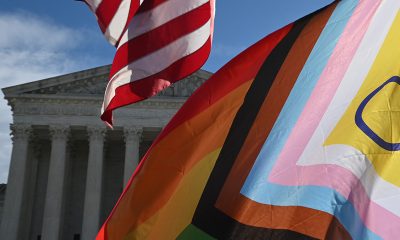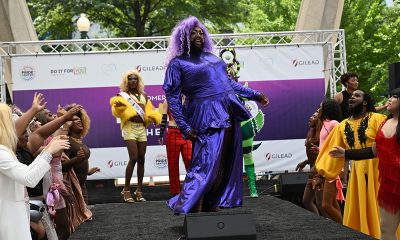National
GLAAD holds second protest outside New York Times
‘Why won’t you meet with trans community leaders?’
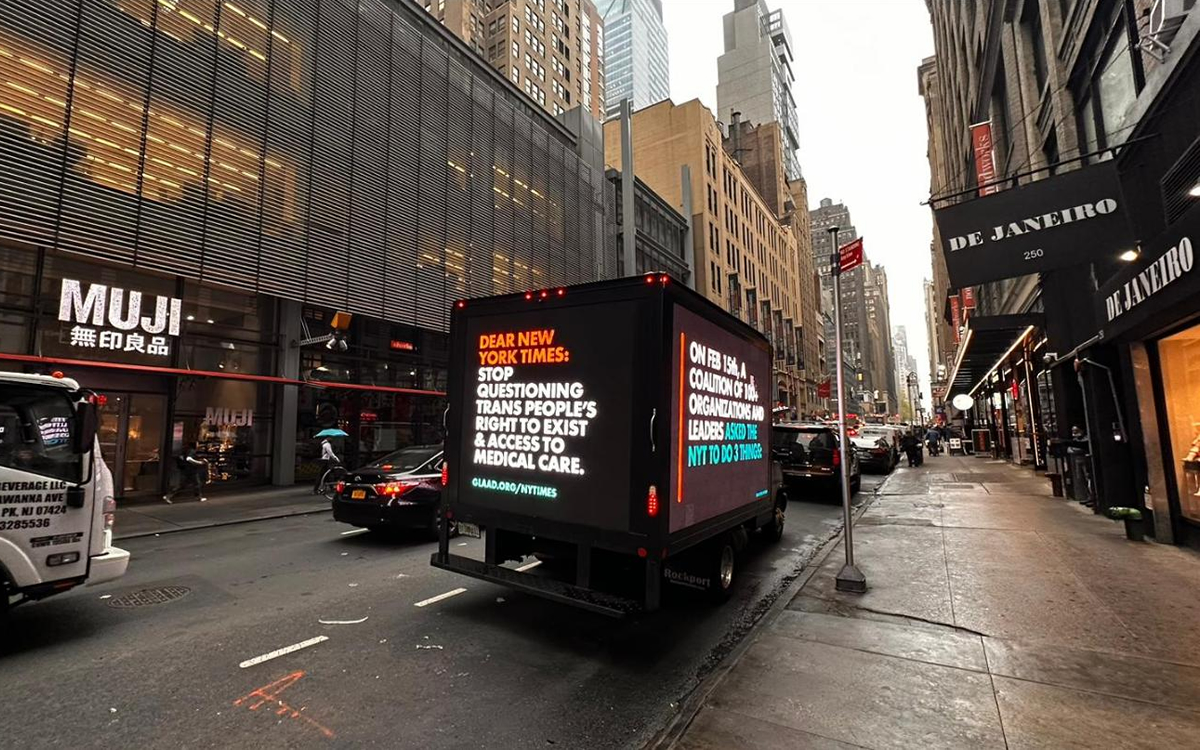
The billboard truck is back. Hired by GLAAD, the vehicle blasting neon messages criticizing the New York Times for its coverage of the transgender community returned to the newspaper’s Manhattan headquarters Monday.
The LGBTQ media advocacy organization leads a coalition of more than 100 advocacy groups, trans journalists and allies demanding the paper’s editors and leadership “stop printing biased, anti-trans stories,” meet with members and leaders in the trans community, and hire at least four trans writers and editors as full-time members of its staff.
It’s been two months since we delivered our letter with other organizations and leaders demanding @nytimes stop printing inaccurate and harmful misinformation about transgender people and issues.
— GLAAD (@glaad) April 17, 2023
We’re back outside the Times building this morning. https://t.co/IkQocps8fS pic.twitter.com/sCHI9GTyJJ
Although the Washington Blade received a response from Charlie Stadtlander, the director of external communications for the Times, following the first protest on Feb. 15, GLAAD’s president and CEO says the newspaper has yet to respond to an open letter released on that date, or to its demands.
“It is outrageous and disrespectful that New York Times leadership continues to ignore the voices of trans community leaders, who have been sounding the alarm about the newspaper’s irresponsible, inaccurate coverage for over a year,” said Sarah Kate Ellis in a statement to the Blade. “Trans people deserve to be respected and have their voices heard. Mainstream media publications, including the Times, have a responsibility to their readers to cover trans people and issues in a fair, accurate and inclusive way.
“Our coalition of more than a hundred organizations and leaders asked that the Times meet with trans community leaders within two months. Two months have come and gone without a word from the Times. What are they afraid of?” said Ellis. “It is beyond unacceptable for the Times to use sensational, inaccurate stories about trans people for clicks, yet refuse to speak with leaders in the trans community.”
GLAAD’s coalition letter was released the same day as another letter co-authored by contributors to the newspaper. ”Some of us are trans, nonbinary, or gender nonconforming, and we resent the fact that our work, but not our person, is good enough for the paper of record. Some of us are cis, and we have seen those we love discover and fight for their true selves, often swimming upstream against currents of bigotry and pseudoscience fomented by the kind of coverage we here protest.”
“I am forever inspired by how generous and courageous NYT contributors and employees involved with the letter have given of their time, energy, heart and belief of potential that our media landscape can serve as a catalyst for change,” said one of the signatories, writer and activist Raquel Willis. “I am also grateful for the numerous organizations that have bolstered the efforts of our journalists in a time when not just facts, but empathy continues to be left on the cutting room floor.”
“I have tracked 430 bills targeting the trans community this year, and I have seen New York Times articles referenced in numerous hearings,” said journalist and researcher Erin Reed. Just last week, Missouri’s attorney general cited a Times article in banning gender affirming care for all transgender people, including adults.
This follows the Missouri AG directly citing Emily Bazelon’s New York Times Magazine article to ban gender affirming care for trans adults. pic.twitter.com/fFMVg8gqgn
— Alejandra Caraballo (@Esqueer_) April 14, 2023
“Accurate and sensitive coverage from the New York Times is of paramount importance,” said Reed. “They need to hire more trans staff, allow trans people to cover the biggest stories that relate to our care, and take responsibility for ensuring their coverage is respectful and accurately portrays the scientific consensus around gender affirming care. I hope to see a real commitment to engaging with the community in the coming days.”
“Their reporting on the transgender community has been anything but accurate and fair,” said Jay Brown, HRC’s senior vice president for programs, research and training. “Gender affirming medical care is widely supported by every major medical association — representing more than 1.3 million doctors — but they’re platforming anti-trans extremists whose only goal is to push us all back into the closet. They aren’t experts and shouldn’t be treated as such. This isn’t a matter of giving equal time to two sides of an issue. It’s about giving radicals a platform that has been used by politicians to harm transgender people — and trans youth in particular. The Times must do better and they should listen to those of us who are transgender when we are telling them their reporting is dangerous.”
In his Feb. 15 statement emailed to the Blade, Stadtlander had this to say in response to the coalition, the open letter and the protest:
“We received the open letter delivered by GLAAD and welcome their feedback. We understand how GLAAD and the co-signers of the letter see our coverage. But at the same time, we recognize that GLAAD’s advocacy mission and the Times’s journalistic mission are different.
“As a news organization, we pursue independent reporting on transgender issues that include profiling groundbreakers in the movement, challenges and prejudice faced by the community and how society is grappling with debates about care.
“The very news stories criticized in their letter reported deeply and empathetically on issues of care and well-being for trans teens and adults. Our journalism strives to explore, interrogate and reflect the experiences, ideas and debates in society — to help readers understand them. Our reporting did exactly that and we’re proud of it.”
Read the letters and who signed them by clicking here.
U.S. Supreme Court
Supreme Court to consider bans on trans athletes in school sports
27 states have passed laws limiting participation in athletics programs
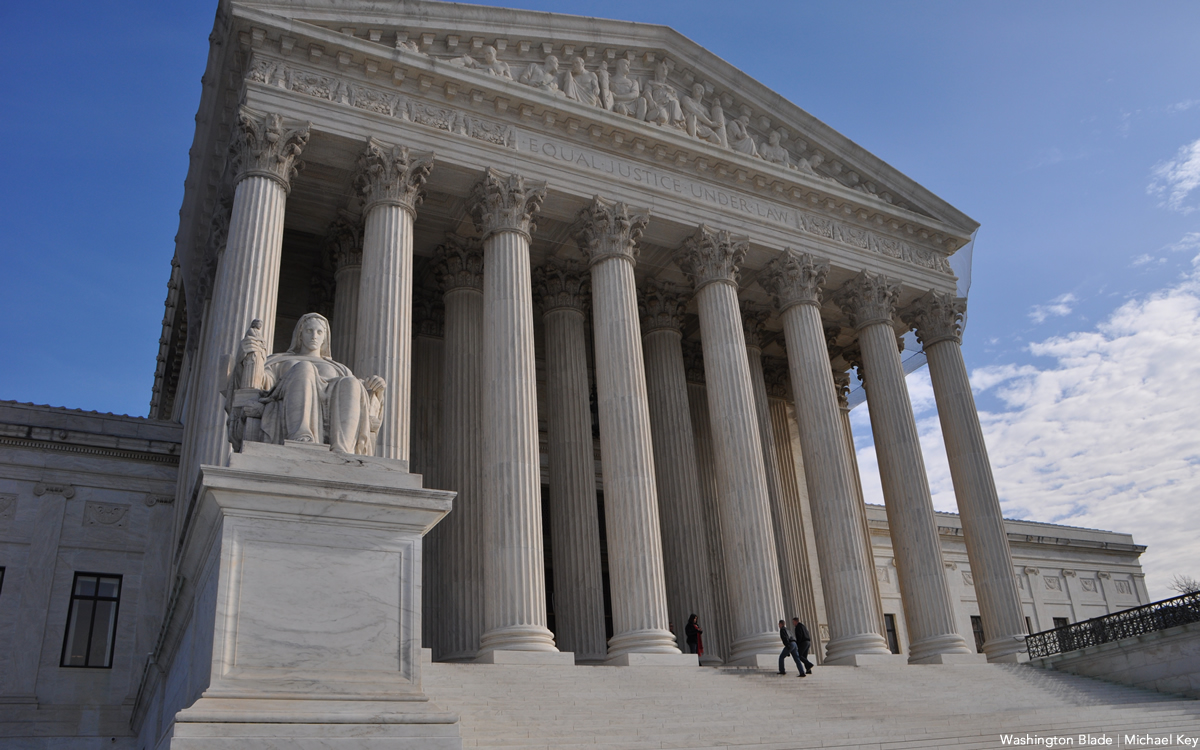
The U.S. Supreme Court on Thursday agreed to hear two cases involving transgender youth challenging bans prohibiting them from participating in school sports.
In Little v. Hecox, plaintiffs represented by the ACLU, Legal Voice, and the law firm Cooley are challenging Idaho’s 2020 ban, which requires sex testing to adjudicate questions of an athlete’s eligibility.
The 9th U.S. Circuit Court of Appeals described the process in a 2023 decision halting the policy’s enforcement pending an outcome in the litigation. The “sex dispute verification process, whereby any individual can ‘dispute’ the sex of any female student athlete in the state of Idaho,” the court wrote, would “require her to undergo intrusive medical procedures to verify her sex, including gynecological exams.”
In West Virginia v. B.P.J., Lambda Legal, the ACLU, the ACLU of West Virginia, and Cooley are representing a trans middle school student challenging the Mountain State’s 2021 ban on trans athletes.
The plaintiff was participating in cross country when the law was passed, taking puberty blockers that would have significantly reduced the chances that she could have a physiological advantage over cisgender peers.
“Like any other educational program, school athletic programs should be accessible for everyone regardless of their sex or transgender status,” said Joshua Block, senior counsel for the ACLU’s LGBTQ and HIV Project. “Trans kids play sports for the same reasons their peers do — to learn perseverance, dedication, teamwork, and to simply have fun with their friends,” Block said.
He added, “Categorically excluding kids from school sports just because they are transgender will only make our schools less safe and more hurtful places for all youth. We believe the lower courts were right to block these discriminatory laws, and we will continue to defend the freedom of all kids to play.”
“Our client just wants to play sports with her friends and peers,” said Lambda Legal Senior Counsel Tara Borelli. “Everyone understands the value of participating in team athletics, for fitness, leadership, socialization, and myriad other benefits.”
Borelli continued, “The U.S. Court of Appeals for the Fourth Circuit last April issued a thoughtful and thorough ruling allowing B.P.J. to continue participating in track events. That well-reasoned decision should stand the test of time, and we stand ready to defend it.”
Shortly after taking control of both legislative chambers, Republican members of Congress tried — unsuccessfully — to pass a national ban like those now enforced in 27 states since 2020.
Federal Government
UPenn erases Lia Thomas’s records as part of settlement with White House
University agreed to ban trans women from women’s sports teams

In a settlement with the Trump-Vance administration announced on Tuesday, the University of Pennsylvania will ban transgender athletes from competing and erase swimming records set by transgender former student Lia Thomas.
The U.S. Department of Education’s Office for Civil Rights found the university in violation of Title IX, the federal rights law barring sex based discrimination in educational institutions, by “permitting males to compete in women’s intercollegiate athletics and to occupy women-only intimate facilities.”
The statement issued by University of Pennsylvania President J. Larry Jameson highlighted how the law’s interpretation was changed substantially under President Donald Trump’s second term.
“The Department of Education OCR investigated the participation of one transgender athlete on the women’s swimming team three years ago, during the 2021-2022 swim season,” he wrote. “At that time, Penn was in compliance with NCAA eligibility rules and Title IX as then interpreted.”
Jameson continued, “Penn has always followed — and continues to follow — Title IX and the applicable policy of the NCAA regarding transgender athletes. NCAA eligibility rules changed in February 2025 with Executive Orders 14168 and 14201 and Penn will continue to adhere to these new rules.”
Writing that “we acknowledge that some student-athletes were disadvantaged by these rules” in place while Thomas was allowed to compete, the university president added, “We recognize this and will apologize to those who experienced a competitive disadvantage or experienced anxiety because of the policies in effect at the time.”
“Today’s resolution agreement with UPenn is yet another example of the Trump effect in action,” Education Secretary Linda McMahon said in a statement. “Thanks to the leadership of President Trump, UPenn has agreed both to apologize for its past Title IX violations and to ensure that women’s sports are protected at the university for future generations of female athletes.”
Under former President Joe Biden, the department’s Office of Civil Rights sought to protect against anti-LGBTQ discrimination in education, bringing investigations and enforcement actions in cases where school officials might, for example, require trans students to use restrooms and facilities consistent with their birth sex or fail to respond to peer harassment over their gender identity.
Much of the legal reasoning behind the Biden-Harris administration’s positions extended from the 2020 U.S. Supreme Court case Bostock v. Clayton County, which found that sex-based discrimination includes that which is based on sexual orientation or gender identity under Title VII rules covering employment practices.
The Trump-Vance administration last week put the state of California on notice that its trans athlete policies were, or once were, in violation of Title IX, which comes amid the ongoing battle with Maine over the same issue.
New York
Two teens shot steps from Stonewall Inn after NYC Pride parade
One of the victims remains in critical condition
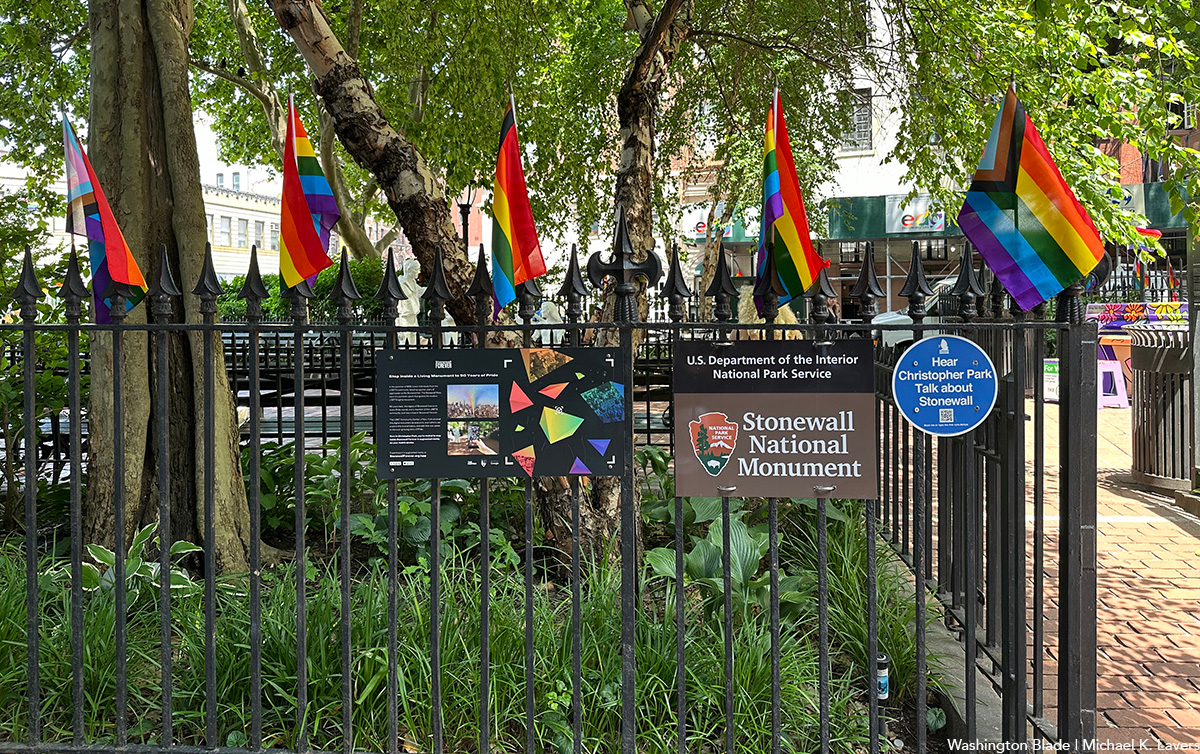
On Sunday night, following the annual NYC Pride March, two girls were shot in Sheridan Square, feet away from the historic Stonewall Inn.
According to an NYPD report, the two girls, aged 16 and 17, were shot around 10:15 p.m. as Pride festivities began to wind down. The 16-year-old was struck in the head and, according to police sources, is said to be in critical condition, while the 17-year-old was said to be in stable condition.
The Washington Blade confirmed with the NYPD the details from the police reports and learned no arrests had been made as of noon Monday.
The shooting took place in the Greenwich Village neighborhood of Manhattan, mere feet away from the most famous gay bar in the city — if not the world — the Stonewall Inn. Earlier that day, hundreds of thousands of people marched down Christopher Street to celebrate 55 years of LGBTQ people standing up for their rights.
In June 1969, after police raided the Stonewall Inn, members of the LGBTQ community pushed back, sparking what became known as the Stonewall riots. Over the course of two days, LGBTQ New Yorkers protested the discriminatory policing of queer spaces across the city and mobilized to speak out — and throw bottles if need be — at officers attempting to suppress their existence.
The following year, LGBTQ people returned to the Stonewall Inn and marched through the same streets where queer New Yorkers had been arrested, marking the first “Gay Pride March” in history and declaring that LGBTQ people were not going anywhere.
New York State Assemblywoman Deborah Glick, whose district includes Greenwich Village, took to social media to comment on the shooting.
“After decades of peaceful Pride celebrations — this year gun fire and two people shot near the Stonewall Inn is a reminder that gun violence is everywhere,” the lesbian lawmaker said on X. “Guns are a problem despite the NRA BS.”
